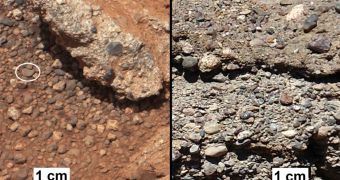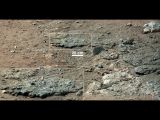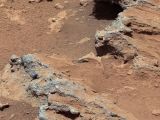NASA has announced that Curiosity has found evidence of an ancient streambed on the surface of Mars.
Images captured during its mission so far have made it possible for scientists to analyze the rock formations and determine they were part of a streambed at one point in their existence.
Researchers identified several sites that fit the bill, all spotted and photographed within the mission's first 40 days.
One of the three "pavement-like" rocks, the one dubbed "Goulburn," was actually immediately next to Curiosity's landing site. The other two, "Link" and "Hottah," were very close by, 50 and 100 meters (165 and 330 feet) from the landing location.
"These conglomerates look amazingly like streambed deposits on Earth," Rebecca Williams of the Planetary Science Institute, said.
She's the lead author of a paper appearing in the journal Sciences describing the detailed analysis of these rock formations and the findings.
"Most people are familiar with rounded river pebbles. Maybe you've picked up a smoothed, round rock to skip across the water. Seeing something so familiar on another world is exciting and also gratifying," she added.
There are plenty of signs that these rocks and other smaller ones (the researchers looked at 515 stones and pebbles) were once part of a streambed. The larger pebbles are grouped together, indicating movement, and then followed by a portion of sand, like on Earth.
In fact, by the arrangement of the pebbles and their sizes, scientists were able to determine the speed of the stream at about walking pace, a meter (three feet) per second. The stream was ankle-deep to hip-deep, the scientists also concluded.
There has already been plenty of evidence that points to a wet past for Mars. Curiosity itself found rocks that were created in the presence of water in conditions very suitable, or at least not harmful to life.
Curiosity has been on Mars for several months now and has done some interesting things, but it's got plenty more to do and see. The great thing about science though is that data gathered today can yield information months or years down the line.
In fact, scientists are still making discoveries and research on the moon rocks the Apollo missions brought back several decades ago. Likewise, data from the Kepler space telescope, which is experiencing some problems and may have to be decommissioned, will keep scientists busy for several more years.

 14 DAY TRIAL //
14 DAY TRIAL // 

